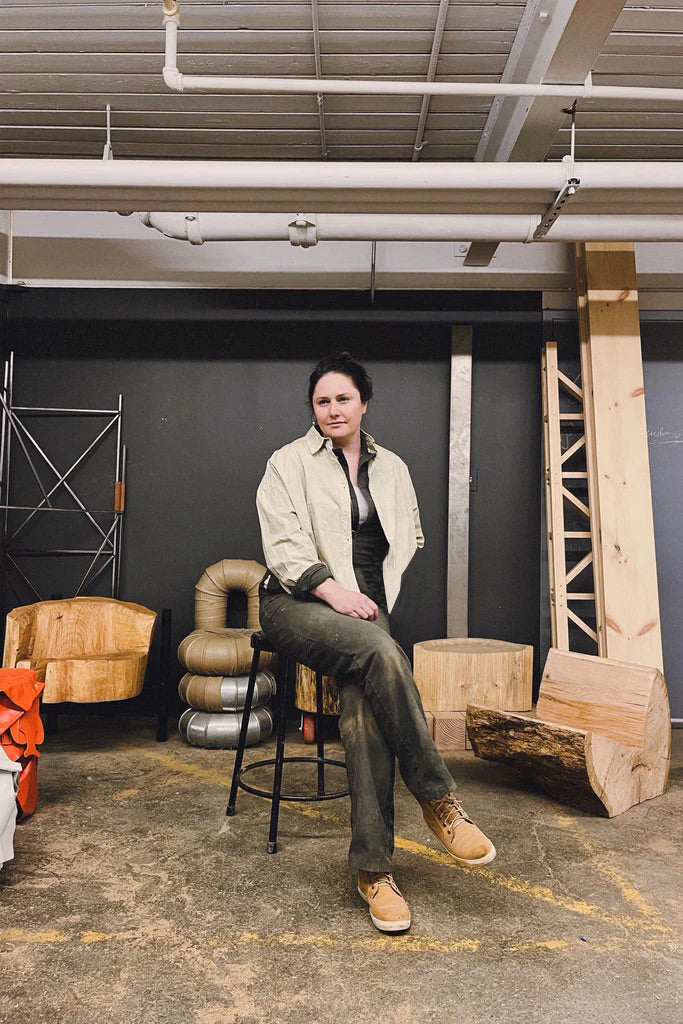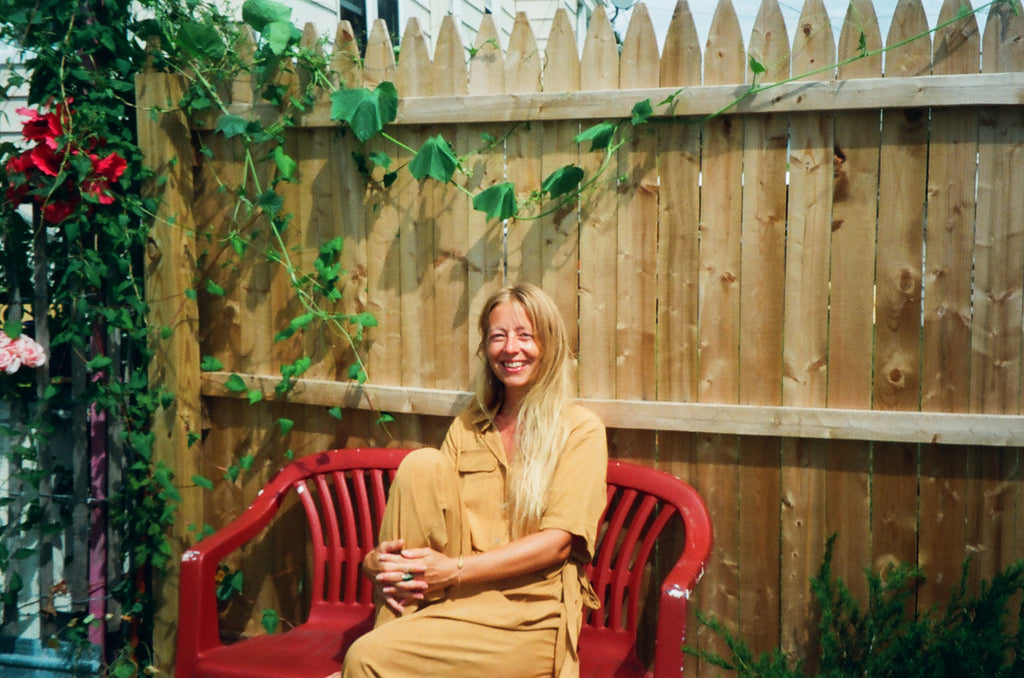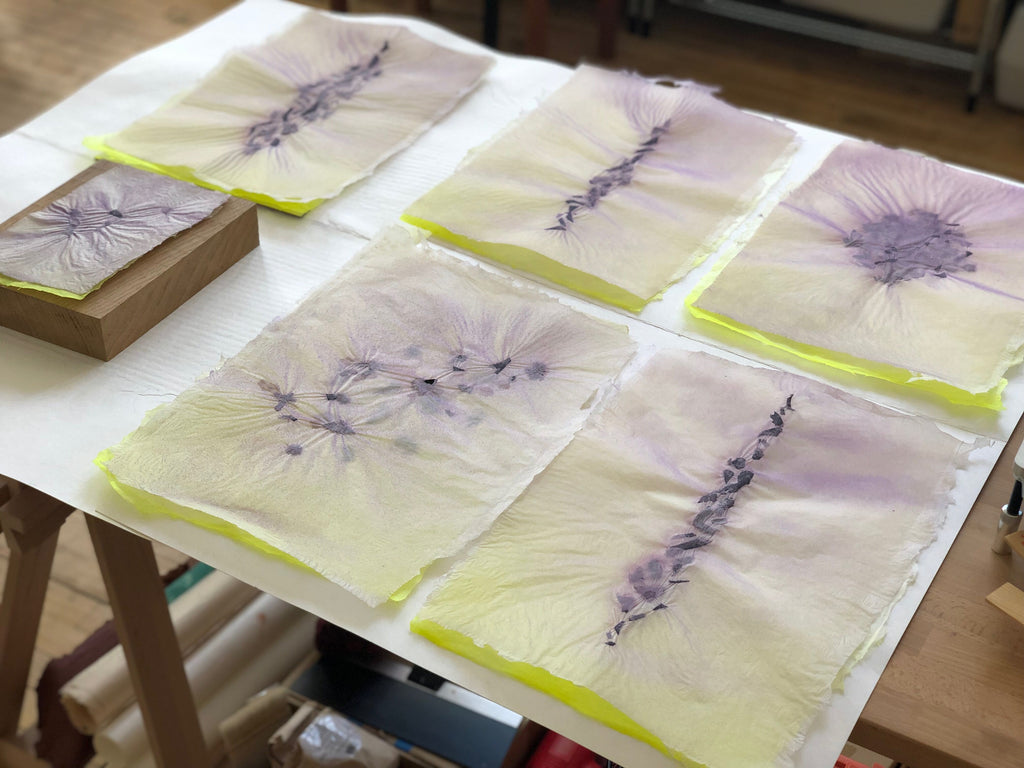LAURA SANSONE, NEW YORK TEXTILE LAB

Laura Sansone of New York Textile Lab, wears the Colorant Ellis Shirt in Mallorca and Bronwyn Dress in Guava at her home and dye garden in Putnam Valley, NY.
Marigold (Tagetes) has a long and rich history as a natural dye, valued for its vibrant gold-yellow to orange hues. Indigenous to Central and South America, marigold flowers were cultivated by the Aztecs, who used the plant not only for ornamental and medicinal purposes but also as a dye source. The bright pigments extracted from marigold petals, primarily caretenoids like lutein, were used to color textiles, particularly in ceremonial and festive garments.

Tell us about your childhood and how did it inspire your work in textiles? I grew up on Long Island in the 70's and 80's. My Dad was a collage artist. His work was very intricate, made up of tiny cut pieces of paper that he would layer or tiny gears and springs from watches and clocks that he would arrange into patterns. His artwork often resembled textiles through color and pattern. I would help him all the time, mainly sorting and organizing lots of collage materials at his drafting table. I think this taught me the patience required to engage in detailed, process oriented handcrafting work. I was heavily influenced by my Dad.
Who has been an inspiration for you? I recently pulled out from storage, a hand crocheted blanket that my Grandma made for me in the 1970's. She made it with wool and acrylic yarn scraps. She has always been a big inspiration for me. She was a professional seamstress and she made me clothes and taught me how to sew and crochet at a very young age. I loved looking through her sewing table and all her supplies. One Christmas, my parents bought me a used Singer sewing machine. I was quite small, and it felt like a real grown up gift. The present that year from my Grandma was a sewing basket with lots of supplies in it. She helped me make some pillows for my dolls that winter. I still think about her when I work in my studio. She really influenced me.
What are the benefits of using climate beneficial wool and how does it tie into regenerative farming? Climate Beneficial™ is a regenerative farming verification that was founded by the nonprofit organization Fibershed in Northern CA. Climate Beneficial™ is a holistic land management program, a verification and a label for the industry. This verification connects brands directly to farms and ranches creating transparency, traceability and trust along their value chain. The climate beneficial program enables brands to internalize the cost of extracting from the land by supporting carbon farming practices, which are protocols that store carbon back in the soil and plant matter. Carbon farm practices are specific to each individual farm and include things like rotational grazing, cover cropping, not till farming, and composting, to name a few. The Climate Beneficial™ Verification is a program modeled from Earth's carbon cycle, which is the most basic, natural system of circularity and reciprocity.
What materials do you like to work with and how do you choose them? I only work with natural materials. I also choose to work with materials that are a part of the Climate Beneficial™ program. Mainly these yarns and textiles are wool, cotton and alpaca blends. Here in NYS, I am a founding member of the Carbon Farm Network cooperative, a group of small brands who work together to make yarn from fibers that are sourced in NYS and grown using Carbon Farming protocols. The membership fees of our cooperative drive funds back into Carbon Farming on our partnering farms.
Do you teach others about sustainable practices in textiles? What's that experience like? I teach a course at Parsons School of Design called Community Supported Textiles. This course addresses bioregional textile production through the use of locally sourced yarns, textiles and natural dyes. My teaching also focuses on building new models for our clothing and textile production systems by shifting from linear, extractive growth models to circular models that are more closely aligned with natural systems. In addition to teaching at Parsons, I consult with designers and teach workshops. It's important for me to share knowledge and raise awareness about the problems that plague our clothing and textile systems. I hope that humans will shift our production and consumption habits away from models that support extraction and exploitation and toward models that foster a collective stewardship for the land, animals and people in our clothing and textile systems. This can only happen when we change our relationship to what we value and internalize the costs of what we make and consume.
Where have you traveled and how has it influenced your textiles research? I've traveled to the Republic of Georgia, Haiti, and Milan to work on textile related projects. The most influential trip for me was Norway though, where I traveled from Bergen up north to the Lofoten Islands to experience their regional fiber and textiles. I got to visit several mills, and manufacturers and learned about the wool tradition there. I also learned about the country's heritage sheep that date back to the age of the Viking people. This experience really influenced me and deepened my desire to build bioregional textile systems here in NYS.
Do you have any future projects you are excited about? I'm excited about growing our Carbon Farm Network, a cooperative and distributed economic model that brings climate beneficial fiber to market. Our cooperative is a slow growth business model, where designers who make more yarn pay more into the membership fee, which goes back into the land conservation on our partnering farms. The more you take from the land, the more you need to give back (reciprocate). Typically, clothing and textile businesses are structured in a way where they are encouraged to make more, so the price point will come down (efficiencies of scale). This leads to "growthism" and over extraction and over consumption. I love working cooperatively and making decisions together with other designers while together, supporting our wool and alpaca growers.
www.newyorktextilelab.com
@nytextilelab





































